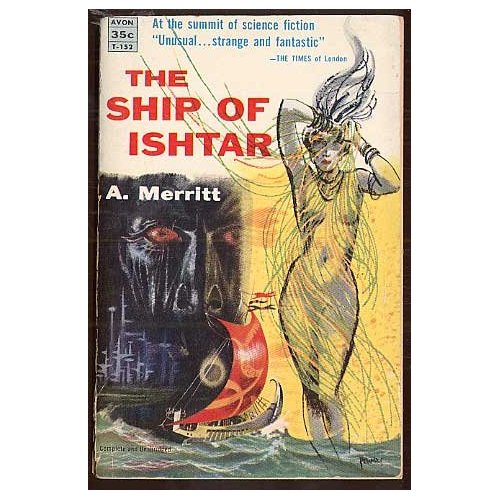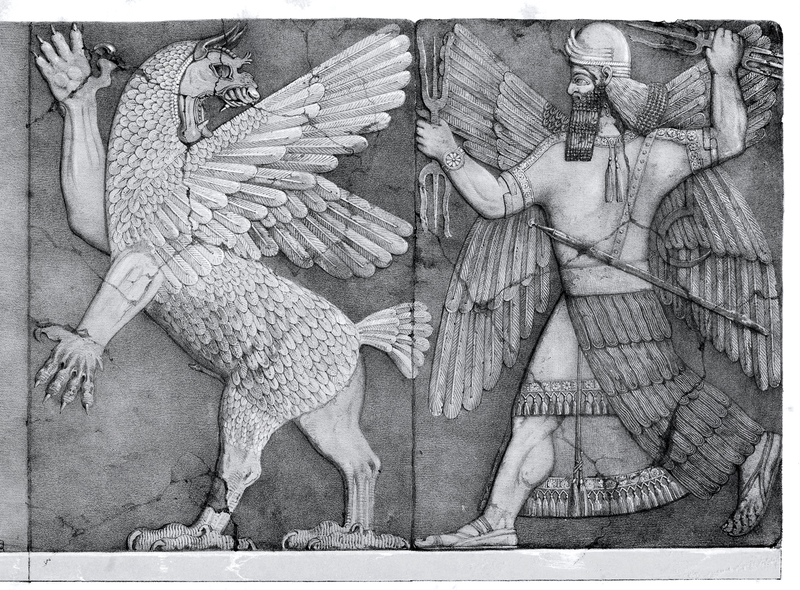
Download it Right
Here
Here
This is one of the best proto Sword and Sorcery novels out there. A great read that plays fast and loose with many of the sword and sorcery conventions.
The Ship of Ishtar is a fantasy novel by A. Merritt. Originally published as a magazine serial in 1924, it has appeared in book form innumerable times.
Plot Overview According To Wiki :
The archaeologist hero, Kenton, receives a mysterious ancient Babylonian artifact, which he discovers contains an incredibly detailed model of a ship. A dizzy spell casts Kenton onto the deck of the ship, which becomes a full-sized vessel sailing an eternal sea. At one end is Sharane the assistant priestess of Ishtar and her female minions, and at the other is Klaneth the assistant priest of Nergal and his male minions, representatives of two opposed deities. None of them can cross an invisible barrier at the midline of the ship, but Kenton can. His arrival destabilizes a situation that had been frozen for 6,000 years, and fantastic adventures ensue.


The novel is not only a rousing fantasy adventure story, but a philosophical exploration of the relationship between material reality and the abstract concepts through which humans struggle to understand it. The reason the ship has been frozen in time is that Zarpanit the head priestess of Ishtar and Alusar the head priest of Nergal fell in love, and were in the midst of making love when their deities possessed them. This placed the hostile deities in an untenable position, especially as they represented cosmic forces that must be kept separate. The result was an imbalance between stability and instability in the universe, freezing the ship in time and rendering unstable its connection to the reality inhabited
Using The Ship of Ishtar
In Your Old School
Sword and Sorcery Campaign

This is a fun read with lots of potential and useful in Sword and Sorcery campaigns. The story crosses many of the conventions that were laid down in Lord Dunsany and fantasy dream worlds of HP Lovecraft. We see the weird dream cycle of strange ships continue with the sword and sorcery work of earlier writers but Michael Moorcock 'The Sailor On The Seas of Fate really nails this theme down establishing it as a convention of the 'gerne'. Many of the conventions of 'The Ships of Ishtar., are same ones that we seen in sword and sorcery novels. Weird time locked events, artifacts as adventure keys, and mankind being the playthings of the gods, and so forth. Add to this the classic artwork of Virgil Finlay and its an entertaining read to be sure and perfect fodder for adventure and campaign source material.
Astonishing Swordsmen and Sorcerers of Hyperborea has many of the conventions of the 'Ship Of Ishtar' built right into it. The ship could well be an artifact of Old Earth and might just turn up in some native shop or bazaar. Other possibilities include other time locked artifacts simply turning up and unleashing their powers upon the PC's. The possibilities really are endless for this classic.
The Cult of Nergal itself has many possibilites as well. We have a very dangerous cult of an ancient lord of the underworld and as such being unleashed upon a campaign world could cause all kinds of untold havoc.
Wiki defines Nergal as :
Being a deity of the desert, god of fire, which is one of negative aspects of the sun, god of the underworld, and also being a god of one of the religions which rivaled Christianity and Judaism, Nergal was sometimes called a demon and even identified with Satan. According to Collin de Plancy and Johann Weyer, Nergal was depicted as the chief of Hell's "secret police", and worked as an "an honorary spy in the service of Beelzebub"
HERE
Using The Ship of Ishtar
In Your Old School
Sword and Sorcery Campaign

This is a fun read with lots of potential and useful in Sword and Sorcery campaigns. The story crosses many of the conventions that were laid down in Lord Dunsany and fantasy dream worlds of HP Lovecraft. We see the weird dream cycle of strange ships continue with the sword and sorcery work of earlier writers but Michael Moorcock 'The Sailor On The Seas of Fate really nails this theme down establishing it as a convention of the 'gerne'. Many of the conventions of 'The Ships of Ishtar., are same ones that we seen in sword and sorcery novels. Weird time locked events, artifacts as adventure keys, and mankind being the playthings of the gods, and so forth. Add to this the classic artwork of Virgil Finlay and its an entertaining read to be sure and perfect fodder for adventure and campaign source material.
Astonishing Swordsmen and Sorcerers of Hyperborea has many of the conventions of the 'Ship Of Ishtar' built right into it. The ship could well be an artifact of Old Earth and might just turn up in some native shop or bazaar. Other possibilities include other time locked artifacts simply turning up and unleashing their powers upon the PC's. The possibilities really are endless for this classic.
The Cult of Nergal itself has many possibilites as well. We have a very dangerous cult of an ancient lord of the underworld and as such being unleashed upon a campaign world could cause all kinds of untold havoc.

Wiki defines Nergal as :
Being a deity of the desert, god of fire, which is one of negative aspects of the sun, god of the underworld, and also being a god of one of the religions which rivaled Christianity and Judaism, Nergal was sometimes called a demon and even identified with Satan. According to Collin de Plancy and Johann Weyer, Nergal was depicted as the chief of Hell's "secret police", and worked as an "an honorary spy in the service of Beelzebub"
Nergal's chief temple at Cuthah bore the name Meslam, from which the god receives the designation of Meslamtaeda or Meslamtaea, "the one that rises up from Meslam". The name Meslamtaeda/Meslamtaea indeed is found as early as the list of gods from Fara while the name Nergal only begins to appear in the Akkadian period. Amongst the Hurrians and later Hittites Nergal was known as Aplu, a name derived from the Akkadian Apal Enlil, (Apal being the construct state of Aplu) meaning "the son of Enlil". As God of the plague, he was invoked during the "plague years" during the reign of the Hittite king Suppiluliuma, when this disease spread from Egypt.
The cult of Nergal does not appear to have spread as widely as that of Ninurta, but in the late Babylonian and early Persian period,syncretism seems to have fused the two divinities, which were invoked together as if they were identical. Hymns and votive and other inscriptions of Babylonian and Assyrian rulers frequently invoke him, but we do not learn of many temples to him outside of Cuthah. The Assyrian king Sennacherib speaks of one at Tarbisu to the north of the Assyrian capital of Nineveh, but significantly, although Nebuchadnezzar II (606 BC - 586 BC), the great temple-builder of the neo-Babylonian monarchy, alludes to his operations at Meslam in Cuthah, he makes no mention of a sanctuary to Nergal in Babylon. Local associations with his original seat—Kutha—and the conception formed of him as a god of the dead acted in making him feared rather than actively worshipped.
More information about this horror right overHERE

Ship of Ishtar was one of my many influences while developing the AS&SH game. Specifically, the character Gigi informed (partly) my conception of AS&SH dwarfs: ". . .His froglike face with the pointed ears; his stunted and bowed legs; his giant's body above the hips; the gigantic shoulders whence swung the long and sinewy and apish arms whose strength Kenton had felt; the slit of a mouth in whose corners a malicious humor dwelt. Something of old earth gods about him; a touch of Pan."
ReplyDeleteAlso, the pyromancer illustration in the AS&SH game is inspired by a Finlay illustration from this book. I showed it to my artist and told him that instead of your typical frail looking mage type, I wanted something like the Finlay illustration in _Ship of Ishtar_. I can't say which Finlay picture it was at the moment, because I don't have the book handy.
Well that's a bit interesting I recently received a package from a reader of this blog. One of the books that was in it was the 'Ship of Ishtar'. I only recently got through reading the book.
ReplyDeleteThe character Gigi reminded me of the early Jack Kirby illustrations of Dwarves in early issues of Marvel's Thor ( yes, I know that Marvel's Thor has nothing to do with the Norse Mythology). The setting, descriptions, and ideas of the Ship of Ishtar are haunting, beautiful, and more then slightly weird.
The Vigil Finlay illustrations are great and I can see where your influences for the artwork in AS&SH might come from easily. I've got to go through more of this package as he week rolls on Lord Ghul and it looks like there is a ton more sword and sorcery stuff here.
Cheers and I hope you have a great weekend!